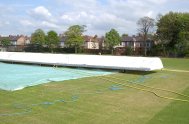
 |
| Index | ||||||
|
Pitch, track, deck, covers, strip, surface  The carefully-prepared rectangle of turf (or artificial surface) on which the bowling and batting actually takes place Originally marked out by stretching a 22 yard length of chain along the ground, a turf cricket pitch is 22 yds (20.12 m) long and 10 ft (3.05m) wide. This 10 ft width is split equally, either side of an imaginary line connecting the two middle stumps in the wickets placed in the bowling creases that mark each end of the pitch The ground authority is responsible for the selection of the pitch and its preparation before the match is undertaken by the groundsman and his staff, but the umpires also have some responsibilities even at this early stage. For example they might decide it is not fit for the match to start on time or even to take place. They should also act to prevent its use by members of either side before play starts. The umpires are responsible for the use and maintenance of the pitch for the duration of the match itself, and it is the umpires alone who decide whether the pitch is fit for play at any given moment It is possible, if uncommon, to change a pitch during a match, but it can only be done if the umpires believe the original one has become unreasonable or dangerous to play on, and if both captains consent to the change. There has to be another pitch available, too, of course!  In professional cricket and in many better-endowed clubs, covers are available and used to protect the
pitch overnight or when the weather is poor. Full covering of the pitch is not permitted under
the Laws
but is frequently written into the playing conditions
of leagues and competitions. In professional cricket and in many better-endowed clubs, covers are available and used to protect the
pitch overnight or when the weather is poor. Full covering of the pitch is not permitted under
the Laws
but is frequently written into the playing conditions
of leagues and competitions. A pitch is sometimes called the track or deck by certain commentators | ||||||